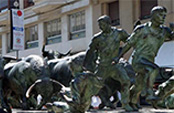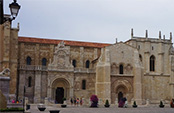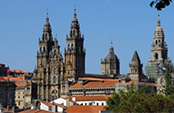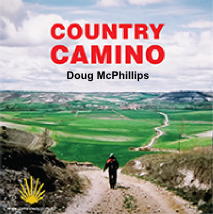Tours - Refer to Caminoways.com for package deals.
 FRENCH WAY CAMINO FRANCE
FRENCH WAY CAMINO FRANCE
The French Way Camino France is the most famous of all the Camino de Santiago routes, featuring in many documentaries, books and movies such as ‘The Way’.
While St Jean Pied de Port is the official starting point of the French Way, many also choose to start their Camino from other points along the route. The most popular starting point is the town of Sarria, in Galicia, 111km away from Santiago.
The last section of the French Way from Sarria to Santiago is also the most social part of the route, where you will meet many fellow pilgrims and find the real spirit and camaraderie of the Camino!
Along the French Way, you will discover beautiful cities, charming medieval towns and stunning landscapes: the Pyrenees, the vineyards of La Rioja, the vast open spaces of the Meseta, the rugged mountains of Léon and O Cebreiro and finally the peaceful hills of rural Galicia before reaching Santiago de Compostela.
This is the full itinerary for the Camino French Way (or Camino France), with traditional stages. Please note that ‘split days’ have not been included in the table.
|
Sections |
Town |
Km |
Section Summary |
|
|
Section 1 |
Saint Jean Pied de Port |
- |
|
|
|
|
Roncesvalles |
26 |
The first section of the French Way, Camino France starts in St Jean Pied de Port in the French Basque Country, crosses the Pyrenees and finishes in the city of Pamplona, world famous for its Bull Run, San Fermin. This is one of the most challenging but beautiful parts, especially if you take the ‘Napoleon Route’ over the Roncesvalles Pass (1450m). The views of the Pyrenees are worth the effort! |
|
|
|
Zubiri |
22 |
||
|
Section 2 |
Pamplona |
20 |
|
|
|
|
Puente de la Reina |
23 |
This section of the Camino de Santiago along the French Way, Camino France starts in the city of Pamplona (Iruna in Basque), famous for its San Fermin Bull Run festival taking place from 7th July every year. The section finishes in Logroño, capital of La Rioja wine region, and a fantastic city to discover authentic Spanish ‘tapas’. From the pilgrim sculpture at Alto del Perdon, you will enjoy panoramic views of Pamplona behind and the vast countryside ahead, before continuing on your way. On this section of the Camino, you will walk across the mountains of Navarra and La Rioja vineyards, passing medieval bridges, castles, churches and picturesque villages along the way, such as Puente de la Reina, Cirauqui, Estella-Lizarra and Viana. Stop at Bodegas Irache and the Wine Museum for a rest and a quick sip at the free wine fountain. |
|
|
|
Estella |
19 |
||
|
|
Los Arcos |
20 |
||
|
Section 3 |
Logroño |
26 |
|
|
|
|
Nájera |
26 |
Section 3 of the Camino de Santiago along the French Way starts in Logroño, capital of the famous Rioja wine region. Explore the city and treat yourself to ‘tapas’ in the lively Calle del Laurel before you start your journey. The terrain becomes easier than in previous stages of the Camino and you will walk sections across undulating farmland and vineyards, passing castles, monasteries and charming villages. One of the highlights is Santo Domingo de la Calzada and its historic centre, an important stop for pilgrims on the Camino since the Middle Ages. You will finish your walk in the majestic city of Burgos, home of ‘El Cid’, where you should visit its magnificent cathedral, possibly the most beautiful in Spain. |
|
|
|
Santo Domingo de la Calzada |
21 |
||
|
|
Belorado |
22 |
||
|
|
St Juan de Ortega |
24 |
||
|
Section 4 |
Burgos |
22 |
|
|
|
|
Hornillos del Camino |
20 |
Section 4 of the Camino de Santiago along the French Way starts in majestic Burgos, hometown of ‘El Cid’ and considered the Gothic capital of Spain. This section of the French Way finishes in the village of Sahagún, in the heart of the Meseta with its vast wide open landscapes. The sounds of nature and endless crop fields will be your companions for this section of the Camino de Santiago, dotted with hamlets, picturesque sleepy villages and Romanesque churches. |
|
|
|
Castrojeriz |
18 |
||
|
|
Frómista |
25 |
||
|
|
Carrión de los Condes |
19 |
||
|
|
Calzadilla de la Cueza |
17 |
||
|
Section 5 |
Sahagún |
22 |
|
|
|
|
El Burgo Ranero |
17 |
Starting in the medieval town of Sahagún, section 5 of the Camino de Santiago along the French Way will take you across the Meseta, the immense Castilian Plateau (900m) and its villages.You will finish this walking section in the city of León, where you can admire the cathedral, the remains of its Roman walls, the Romanesque Royal Basilica of Saint Isidoro and GaudÒs neo-Gothic Casa de Botines. |
|
|
|
Mansilla de las Mullas |
19 |
||
|
Section 6 |
León |
17 |
|
|
|
|
Mazarife |
22 |
Section 6 of the Camino de Santiago along the French Way starts in the lively city of León and finishes in Ponferrada, built by the Templars in the 12th century. Along the way, you will pass the hilltop city of Astorga famous for its chocolates and other sweet delicacies. After Astorga, you will start your ascent to the spectacular and unscathed León Mountains (Montes de León), passing rustic mountain villages and hamlets before reaching El Bierzo region. Your destination for this Camino section is Ponferrada, capital of El Bierzo region and the last city before Santiago de Compostela. |
|
|
|
Astorga |
30 |
||
|
|
Rabanal del Camino |
19 |
||
|
Section 7 |
Ponferrada |
32 |
|
|
|
|
Villafranca del Bierzo |
23 |
Section 7 of the Camino de Santiago along the French Way starts in Ponferrada, with its imposing Templars Castle, and finishes in the market town of Sarria, the most popular Camino starting point. You will begin your journey heading to Villafranca del Bierzo, a gorgeous town surrounded by idyllic countryside. After Villafranca, a challenging ascent will lead to the mountains of O Cebreiro. You will enter Galicia via O Cebreiro, a stunning mountain village in a region of outstanding natural beauty. After O Cebreiro, the Camino will continue along forest tracks towards Sarria, just over 100km away from Santiago. An alternative route will take you by the impressive Samos Monastery. |
|
|
|
O Cebreiro |
28 |
||
|
|
Triacastela |
21 |
||
|
Section 8 |
Sarria |
21 |
|
|
|
|
PortomarÃn |
23 |
This is the most popular walking tour of the Camino de Santiago. Perfect for those looking to capture the essence of the Camino: a nice walk, good food and wine, discovering local customs, meeting fellow pilgrims and enjoying the unique atmosphere of it all. You won’t forget a single minute of it!This section of the Camino de Santiago starts in Sarria and covers the last 100km of the Camino Francés, the minimum required to apply for your Compostela certificate. The Camino will take you across woodlands, farmland and rustic hamlets, following tracks and paths lined by granite stone walls. The green rolling landscape of Galicia is part of each day’s walk, until you approach your final destination: the mythical city of Santiago de Compostela. |
|
|
|
Palas do Rei |
23 |
||
|
|
Arzúa |
28 |
||
|
|
Rúa |
18 |
||
|
 |
Santiago de C. |
19 |
|
|
Read More
The French Way follows an ancient pilgrim path across the North of the Peninsula, passing amazing cities and areas of natural beauty such as Pamplona, famous for its bull run; La Rioja wine region and its capital Logroño; Burgos with its magnificent cathedral; elegant Léon and Ponferrada with its Templars Castle. From Ponferrada, the Way enters Galicia through the mountains and picturesque village of O Cebreiro.
The gorgeous red and white town of St Jean Pied de Port is the starting point of the French Way. Over 20,000 pilgrims choose to start their ‘way’ to Santiago de Compostela in Saint Jean Pied each year, covering nearly 800km across the North of Spain. Many also choose to start their Camino from other points along the route, the most popular being Sarria; followed by the city of León and the picturesque mountain village of O Cebreiro.
History
 The French Way is the most traditional of all the pilgrim routes to Santiago and the best known internationally.The trail was established in the late 11th century thanks to the efforts of monarchs like Sancho III the Greater and Sancho RamÃrez de Navarra y Aragón, as well as Alphonse VI and his successors, who took care of its construction and promotion. The main routes of the Way in France and Spain were described in detail around the year 1135 in the Codex Calixtinus, an essential reference work providing details of the pilgrimage.
The French Way is the most traditional of all the pilgrim routes to Santiago and the best known internationally.The trail was established in the late 11th century thanks to the efforts of monarchs like Sancho III the Greater and Sancho RamÃrez de Navarra y Aragón, as well as Alphonse VI and his successors, who took care of its construction and promotion. The main routes of the Way in France and Spain were described in detail around the year 1135 in the Codex Calixtinus, an essential reference work providing details of the pilgrimage.
Book V of this Codex is a bona-fide medieval guidebook to the pilgrimage to Santiago. It lists the different stretches of the French Way from the lands of Gaul and offers detailed information on the sanctuaries to be found along the way, including notes on the hospitality, the people, food, natural springs, local customs, etc. The entire work is written clearly and succinctly, as a practical guide for the Medieval pilgrim heading to Santiago.
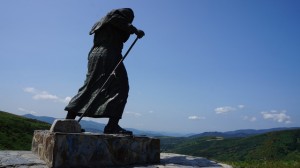 This guide, attributed to the French cleric Aymeric Picaud, reveals the political and religious interest that lay behind promoting the sanctuary of Santiago de Compostela and making it easily accessible, yet it also bears testimony to the demand for this type of information. At the time of writing, the French Way and the pilgrimages had reached their heyday. Santiago became a destination for pilgrims from the entire Christian world. This surge of pilgrims was so intense that it prompted a Moslem Ambassador to state that “the throng of worshippers who travel to Santiago and back is so great that there is almost no room left on the road leading to the west”.
This guide, attributed to the French cleric Aymeric Picaud, reveals the political and religious interest that lay behind promoting the sanctuary of Santiago de Compostela and making it easily accessible, yet it also bears testimony to the demand for this type of information. At the time of writing, the French Way and the pilgrimages had reached their heyday. Santiago became a destination for pilgrims from the entire Christian world. This surge of pilgrims was so intense that it prompted a Moslem Ambassador to state that “the throng of worshippers who travel to Santiago and back is so great that there is almost no room left on the road leading to the west”.
Over the centuries and with the political and religious avatars in Europe, the French Way route lost much of its former influence. It was not until the end of the 19th century when interest in Saint James and the Way experienced some resurgence. Interest continued to grow in the second half of the 20th century, with the progressive restoration and recovery of this ancient trail, which has been internationally recognised as one of the historical symbols of European unity â“ and was chosen as the first European Cultural Itinerary by the Council of Europe in 1987.
For more information please contact us - click here
website: www.CaminoWay.com.au - email: pilgrim@caminoway.com.au
All material on this website is copyright © website by: www.thenet.com.au | Privacy Policy


